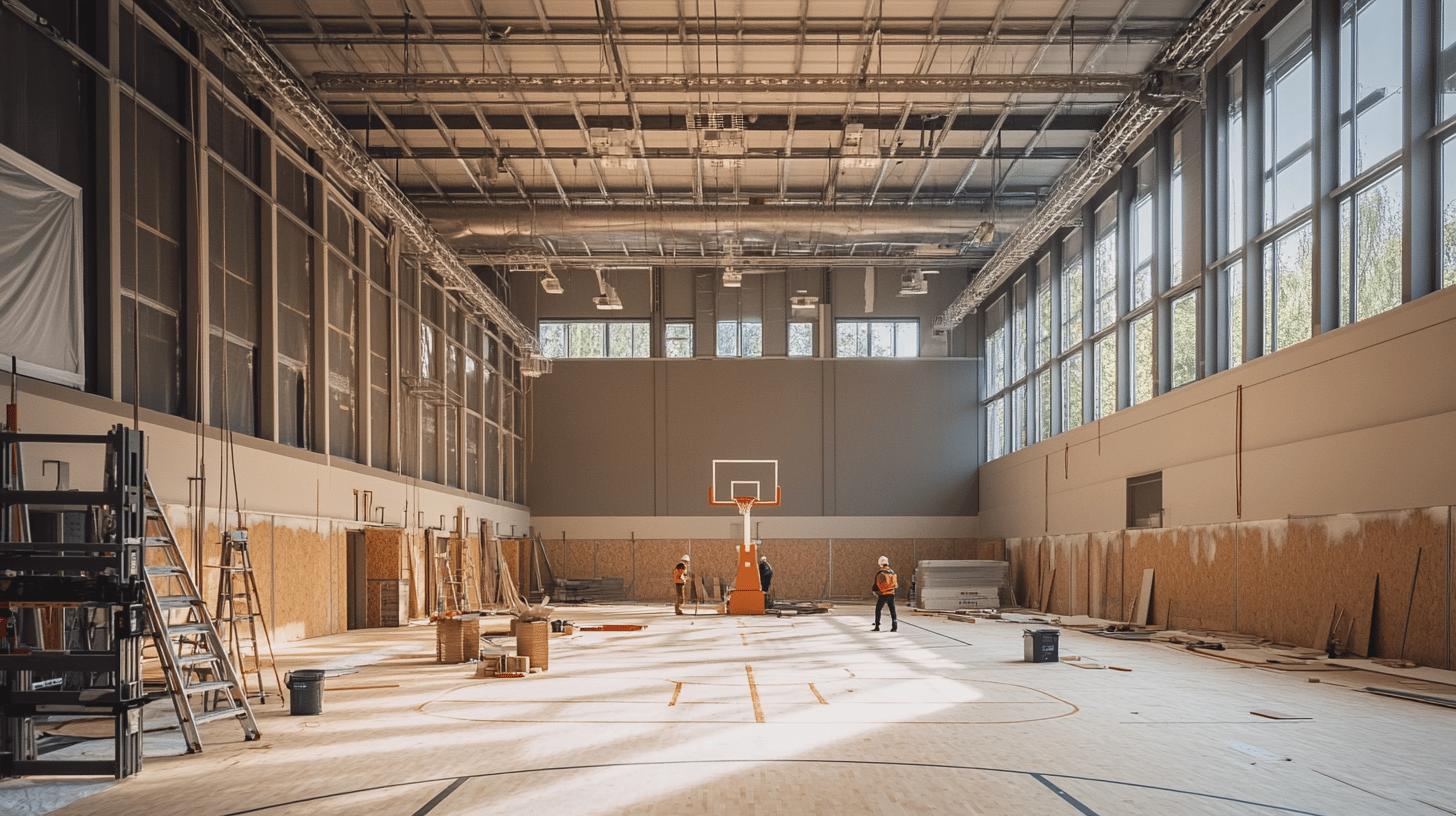Imagine planning a court resurfacing project without any idea of how long the closure might last. The unpredictability of downtime can disrupt sports facility schedules, affecting both revenue and athlete satisfaction. Thankfully, Courtship Floorings presents the Court Resurfacing Downtime Calculator, a strategic tool for seamless planning. This calculator empowers sports facility managers by providing accurate, data-driven closure timelines, ensuring minimal disruption. Through comprehensive downtime assessment and efficient time management, it revolutionises project planning. Explore how this innovative tool can transform closure planning, streamline operations, and enhance facility management. Read on to discover its full potential.
Understanding the Court Resurfacing Downtime Calculator
The court resurfacing downtime calculator is an essential tool for facility managers aiming to streamline the planning and execution of court closure projects. Its primary purpose is to accurately estimate the duration and impact of resurfacing activities, allowing for efficient scheduling and management of resources. By utilising precise data collection methods, such as the Stopwatch Approach and the Deduction Method, this calculator enhances the accuracy of downtime assessments. This ensures that facility managers can make informed decisions, thereby minimising disruptions to users and optimising the facility’s operational efficiency. The calculator’s ability to provide clear timelines and budget estimates facilitates improved time management and project planning, ultimately reducing the risk of unplanned downtime.
- Data Accuracy: Incorporates precise calculation methods to ensure reliable outcomes.
- User-Friendliness: Designed with an intuitive interface for ease of use by facility managers.
- Integration: Compatible with existing systems to streamline data input and output.
- Customisation: Offers tailored estimates based on specific project parameters.
- Comprehensive Reporting: Provides detailed reports to aid in decision-making.
.
By effectively anticipating potential delays and logistical challenges, the court resurfacing downtime calculator aids in reducing unplanned downtime. It empowers facility managers to proactively address issues, ensuring that their courts remain accessible and meet user needs efficiently. This tool serves as a valuable asset in maintaining the balance between necessary maintenance and user convenience, ultimately contributing to the longevity and performance of sports facilities.
Factors Affecting Resurfacing Time
Resurfacing a court is a meticulous process involving several key stages. Initially, site preparation is crucial to ensure that the surface is ready for the new layers. This phase includes cleaning, repairing any structural issues, and verifying proper grading and drainage to prevent future problems. Following this, the application of new surface layers occurs. Each layer requires adequate curing time to achieve the desired finish and durability. These steps are integral components of the resurfacing schedule and are critical to maintaining the court’s integrity and playability in the long term.
Material selection significantly impacts the resurfacing project timeline. For instance, certain materials may require longer curing periods or additional preparation, influencing the overall schedule. Additionally, environmental conditions play a pivotal role. Unfavourable weather, such as excessive rain or extreme temperatures, can delay the process by affecting the curing time or the application of surface materials. Thus, careful consideration of both material properties and prevailing weather conditions is essential for accurate timeline predictions and effective project management.
Contractor availability and scheduling logistics further influence the resurfacing timeline. The selection of skilled contractors ensures that the project adheres to the planned schedule, as their expertise can mitigate unexpected delays. Furthermore, coordinating with contractors to align with optimal weather conditions and material delivery schedules is crucial. This alignment allows for the efficient progression of the resurfacing stages, minimising downtime and ensuring timely project completion.
Minimising Closure Impact and Optimising Scheduling

Effective planning and communication are paramount in reducing the inconvenience caused by court closures during resurfacing projects. By utilising the court resurfacing downtime calculator, facility managers can accurately predict timelines and costs, allowing for transparent communication with stakeholders. This transparency helps manage expectations and minimises the impact on users. Engaging with stakeholders, including athletes, coaches, and facility staff, ensures that everyone is informed and prepared for the closure, reducing potential conflicts and disruptions. Additionally, planning closures during off-peak seasons can significantly decrease user impact, as fewer players and events will be affected. This strategic approach aids in maintaining user satisfaction and operational efficiency.
- Choose off-peak seasons to minimise user disruption.
- Communicate closure details and timelines with all stakeholders.
- Coordinate with contractors to extend working hours for faster completion.
- Develop a detailed schedule to track progress and adjust as needed.
- Offer alternative facilities or services during the closure.
- Conduct regular updates and feedback sessions with users and staff.
.
A well-planned closure not only minimises inconvenience but also optimises the resurfacing schedule. By proactively addressing potential challenges, such as weather delays or material shortages, facility managers can reduce downtime and ensure timely project completion. The downtime calculator is an invaluable tool in this process, providing precise estimates that facilitate better decision-making and resource allocation. Ultimately, a strategically planned closure enhances the facility’s operational continuity, ensuring it remains a valuable asset to the community.
Material Choices and Their Impact on Resurfacing
Material choice plays a pivotal role in the resurfacing process, directly affecting court performance and maintenance requirements. Common materials used for court surfaces include clay, asphalt, and synthetic grass. Each offers unique benefits; for instance, clay provides a softer playing surface, which can reduce joint strain for players, but requires regular maintenance to maintain its optimal condition. Asphalt surfaces are known for their durability and low maintenance needs, making them a popular choice for high-traffic areas. Synthetic grass, on the other hand, offers the aesthetics of natural grass with reduced upkeep, though it may involve higher initial installation costs.
- Clay: Soft surface, reduces player strain, high maintenance.
- Asphalt: Durable, low maintenance, suited for high use.
- Synthetic Grass: Aesthetic appeal, reduced upkeep, higher initial cost.
- Concrete: Long-lasting, minimal maintenance, harder surface.
.
The selection of the appropriate material significantly influences the court’s longevity and usability. For example, courts surfaced with durable materials like asphalt or concrete may require less frequent resurfacing, thus reducing long-term costs. Conversely, while synthetic grass may incur higher upfront costs, its reduced maintenance needs could offer savings over time. Evaluating the balance between initial investment and ongoing maintenance is essential to ensure the court remains a valuable, long-lasting asset.
Using the Resurfacing Downtime Calculator: Step-by-Step Guide
The court resurfacing downtime calculator is a vital tool designed to streamline project planning by offering immediate, tailored estimates for both costs and timelines. Its user-friendly interface enables facility managers to input specific parameters, ensuring precise downtime assessments that are crucial for efficient budgeting and scheduling. By providing quick, reliable estimates, the calculator aids in creating accurate project timelines, allowing managers to allocate resources effectively and minimise disruptions.
- Enter Court Dimensions: Start by inputting the precise measurements of your court to ensure the calculator provides a tailored assessment.
- Select Resurfacing Type: Choose the type of resurfacing required, such as asphalt or synthetic grass, to receive material-specific estimates.
- Input Project Parameters: Adjust for any additional project specifics, like the number of courts or unique site conditions, to refine the timeline.
- Review Timeline Estimates: Examine the projected timeline for completion, which includes curing times and potential delays due to material constraints.
- Generate Comprehensive Report: Obtain a detailed report outlining the cost breakdown, timeline, and any identified risks, facilitating informed decision-making.
.
Leveraging the court resurfacing downtime calculator enhances project efficiency by providing precise, actionable insights. By accurately assessing downtime and generating detailed reports, facility managers can make informed decisions, optimise resource allocation, and effectively communicate timelines with stakeholders. This proactive approach ensures that resurfacing projects are completed within budget and on schedule, maintaining the facility’s availability and user satisfaction.
Final Words
Navigating the challenges of court resurfacing requires meticulous planning and effective use of tools. The Court Resurfacing Downtime Calculator simplifies complex project management by providing precise timelines and cost estimates, catering to the unique needs of each facility. By understanding key material choices and adopting downtime reduction strategies, managers can enhance the user experience and maintain operational efficiency. Leveraging this calculator is an invaluable resource for planning closures, ensuring a seamless resurfacing process, and ultimately delivering an optimal sports environment. The result is effective time management and improved facility performance.
Overnight Flooring Services: Ensure Seamless Facility Operations
Get resurfacing dates → Floor Refurbishment
FAQ
Q: How does a court resurfacing downtime calculator assist in planning closures?
A: A court resurfacing downtime calculator helps optimise scheduling by providing accurate estimates for closure duration. This aids facility managers in planning and reducing user inconvenience.
Q: What is the cost of resurfacing a tennis court with asphalt?
A: The cost to resurface an asphalt tennis court can vary, but using a calculator can give precise estimates tailored to the project’s specific parameters and conditions.
Q: What are the advantages of using the resurfacing downtime calculator?
A: The calculator enhances time management and project planning by ensuring data accuracy, simplifying processes, and integrating with existing systems for seamless project execution.
Q: How much does it cost to build a concrete tennis court?
A: Building a concrete tennis court involves significant investment, but the total cost can be effectively calculated using a cost calculator, accounting for all necessary factors down to specific elements.
Q: What should be considered when selecting materials for tennis court resurfacing?
A: When selecting materials, consider factors like durability, maintenance needs, and how each option, such as clay or synthetic grass, affects court performance and longevity.
Q: Why is communication important in minimising the impact of court closures?
A: Effective communication and stakeholder engagement minimise disruption, ensuring all parties are informed and prepared, reducing the negative impact on users during court closures.
Q: What are the United States Tennis Association (USTA) standards for court design?
A: USTA standards ensure courts meet specific dimensions, surface characteristics, and markings for optimal playability and safety, guiding both construction and maintenance efforts.
Q: How can resurfacing schedules be optimised?
A: Optimum scheduling involves strategic planning, utilising downtime calculators and coordinating with contractors for variables like weather, material delivery, and extended working hours.


